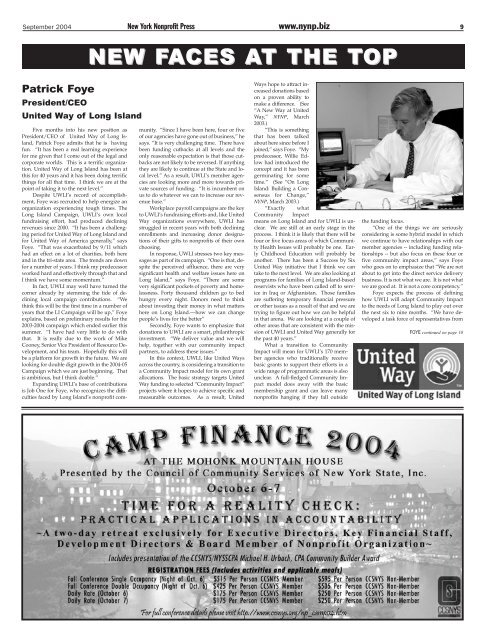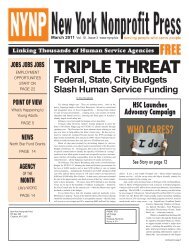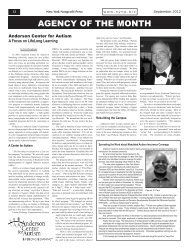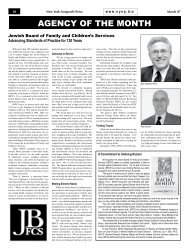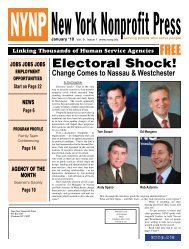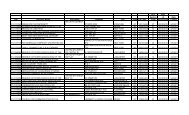September Edition 2004 - New York Nonprofit Press
September Edition 2004 - New York Nonprofit Press
September Edition 2004 - New York Nonprofit Press
Create successful ePaper yourself
Turn your PDF publications into a flip-book with our unique Google optimized e-Paper software.
<strong>September</strong> <strong>2004</strong> <strong>New</strong> <strong>York</strong> <strong>Nonprofit</strong> <strong>Press</strong> www.nynp.biz 9<br />
NEW FACES F<br />
AT THE TOP<br />
Patrick Foye<br />
President/CEO<br />
United Way of Long Island<br />
Five months into his new position as<br />
President/CEO of United Way of Long Island,<br />
Patrick Foye admits that he is having<br />
fun. “It has been a real learning experience<br />
for me given that I come out of the legal and<br />
corporate worlds. This is a terrific organization.<br />
United Way of Long Island has been at<br />
this for 40 years and it has been doing terrific<br />
things for all that time. I think we are at the<br />
point of taking it to the next level.”<br />
Despite UWLI’s record of accomplishment,<br />
Foye was recruited to help energize an<br />
organization experiencing tough times. The<br />
Long Island Campaign, UWLI’s own local<br />
fundraising effort, had produced declining<br />
revenues since 2000. “It has been a challenging<br />
period for United Way of Long Island and<br />
for United Way of America generally,” says<br />
Foye. “That was exacerbated by 9/11 which<br />
had an effect on a lot of charities, both here<br />
and in the tri-state area. The trends are down<br />
for a number of years. I think my predecessor<br />
worked hard and effectively through that and<br />
I think we have some momentum.”<br />
In fact, UWLI may well have turned the<br />
corner already by stemming the tide of declining<br />
local campaign contributions. “We<br />
think this will be the first time in a number of<br />
years that the LI Campaign will be up,” Foye<br />
explains, based on preliminary results for the<br />
2003-<strong>2004</strong> campaign which ended earlier this<br />
summer. “I have had very little to do with<br />
that. It is really due to the work of Mike<br />
Cooney, Senior Vice President of Resource Development,<br />
and his team. Hopefully this will<br />
be a platform for growth in the future. We are<br />
looking for double digit growth in the <strong>2004</strong>-05<br />
Campaign which we are just beginning. That<br />
is ambitious, but I think doable.”<br />
Expanding UWLI’s base of contributions<br />
is Job One for Foye, who recognizes the difficulties<br />
faced by Long Island’s nonprofit community.<br />
“Since I have been here, four or five<br />
of our agencies have gone out of business,” he<br />
says. “It is very challenging time. There have<br />
been funding cutbacks at all levels and the<br />
only reasonable expectation is that those cutbacks<br />
are not likely to be reversed. If anything<br />
they are likely to continue at the State and local<br />
level.” As a result, UWLI’s member agencies<br />
are looking more and more towards private<br />
sources of funding. “It is incumbent on<br />
us to do whatever we can to increase our revenue<br />
base.”<br />
Workplace payroll campaigns are the key<br />
to UWLI’s fundraising efforts and, like United<br />
Way organizations everywhere, UWLI has<br />
struggled in recent years with both declining<br />
enrollments and increasing donor designations<br />
of their gifts to nonprofits of their own<br />
choosing.<br />
In response, UWLI stresses two key messages<br />
as part of its campaign. “One is that, despite<br />
the perceived affluence, there are very<br />
significant health and welfare issues here on<br />
Long Island,” says Foye. “There are some<br />
very significant pockets of poverty and homelessness.<br />
Forty thousand children go to bed<br />
hungry every night. Donors need to think<br />
about investing their money in what matters<br />
here on Long Island.—how we can change<br />
people’s lives for the better”<br />
Secondly, Foye wants to emphasize that<br />
donations to UWLI are a smart, philanthropic<br />
investment. “We deliver value and we will<br />
help, together with our community impact<br />
partners, to address these issues.”<br />
In this context, UWLI, like United Ways<br />
across the country, is considering a transition to<br />
a Community Impact model for its own grant<br />
allocations. The basic strategy targets United<br />
Way funding to selected “Community Impact”<br />
projects where it hopes to achieve specific and<br />
measurable outcomes. As a result, United<br />
Ways hope to attract increased<br />
donations based<br />
on a proven ability to<br />
make a difference. (See<br />
“A <strong>New</strong> Way at United<br />
Way,” NYNP, March<br />
2003.)<br />
“This is something<br />
that has been talked<br />
about here since before I<br />
joined,” says Foye. “My<br />
predecessor, Willie Edlow<br />
had introduced the<br />
concept and it has been<br />
germinating for some<br />
time.” (See “On Long<br />
Island: Building a Consensus<br />
for Change,”<br />
NYNP, March 2003.)<br />
“Exactly what<br />
Community Impact<br />
means on Long Island and for UWLI is unclear.<br />
We are still at an early stage in the<br />
process. I think it is likely that there will be<br />
four or five focus areas of which Community<br />
Health Issues will probably be one. Early<br />
Childhood Education will probably be<br />
another. There has been a Success by Six<br />
United Way initiative that I think we can<br />
take to the next level. We are also looking at<br />
programs for families of Long Island-based<br />
reservists who have been called off to service<br />
in Iraq or Afghanistan. Those families<br />
are suffering temporary financial pressure<br />
or other issues as a result of that and we are<br />
trying to figure out how we can be helpful<br />
in that arena. We are looking at a couple of<br />
other areas that are consistent with the mission<br />
of UWLI and United Way generally for<br />
the past 40 years.”<br />
What a transition to Community<br />
Impact will mean for UWLI’s 170 member<br />
agencies who traditionally receive<br />
basic grants to support their efforts in a<br />
wide range of programmatic areas is also<br />
unclear. A full-fledged Community Impact<br />
model does away with the basic<br />
membership grant and can leave many<br />
nonprofits hanging if they fall outside<br />
the funding focus.<br />
“One of the things we are seriously<br />
considering is some hybrid model in which<br />
we continue to have relationships with our<br />
member agencies -- including funding relationships<br />
-- but also focus on these four or<br />
five community impact areas,” says Foye<br />
who goes on to emphasize that “We are not<br />
about to get into the direct service delivery<br />
business. It is not what we are. It is not what<br />
we are good at. It is not a core competency.”<br />
Foye expects the process of defining<br />
how UWLI will adapt Community Impact<br />
to the needs of Long Island to play out over<br />
the next six to nine months. “We have developed<br />
a task force of representatives from<br />
FOYE continued on page 10


